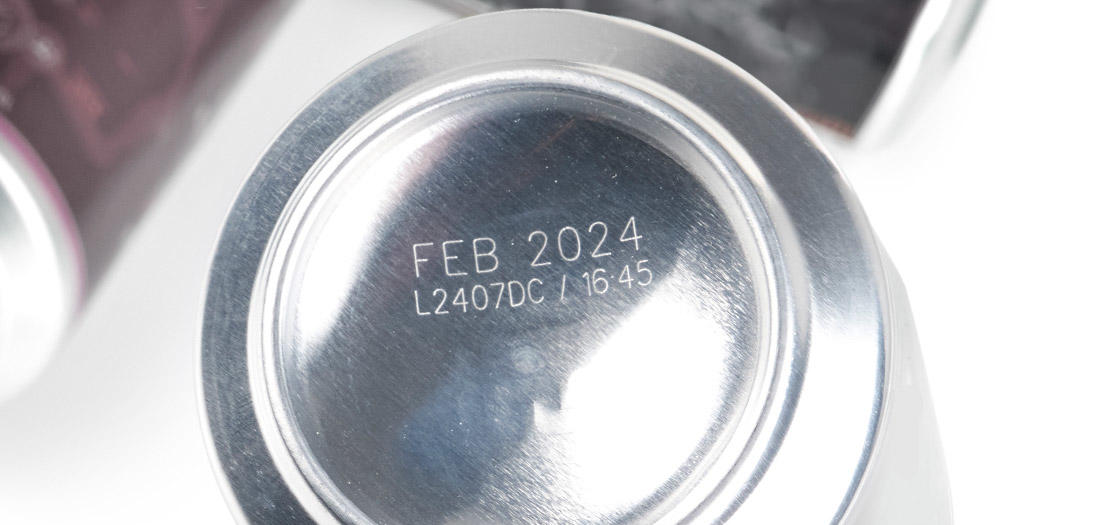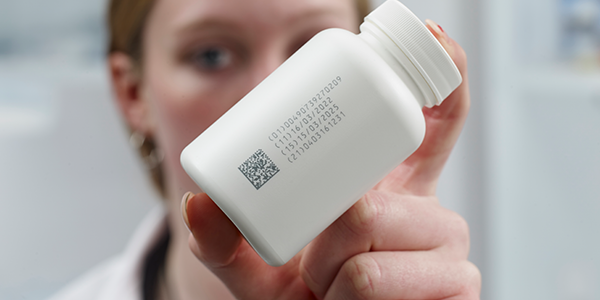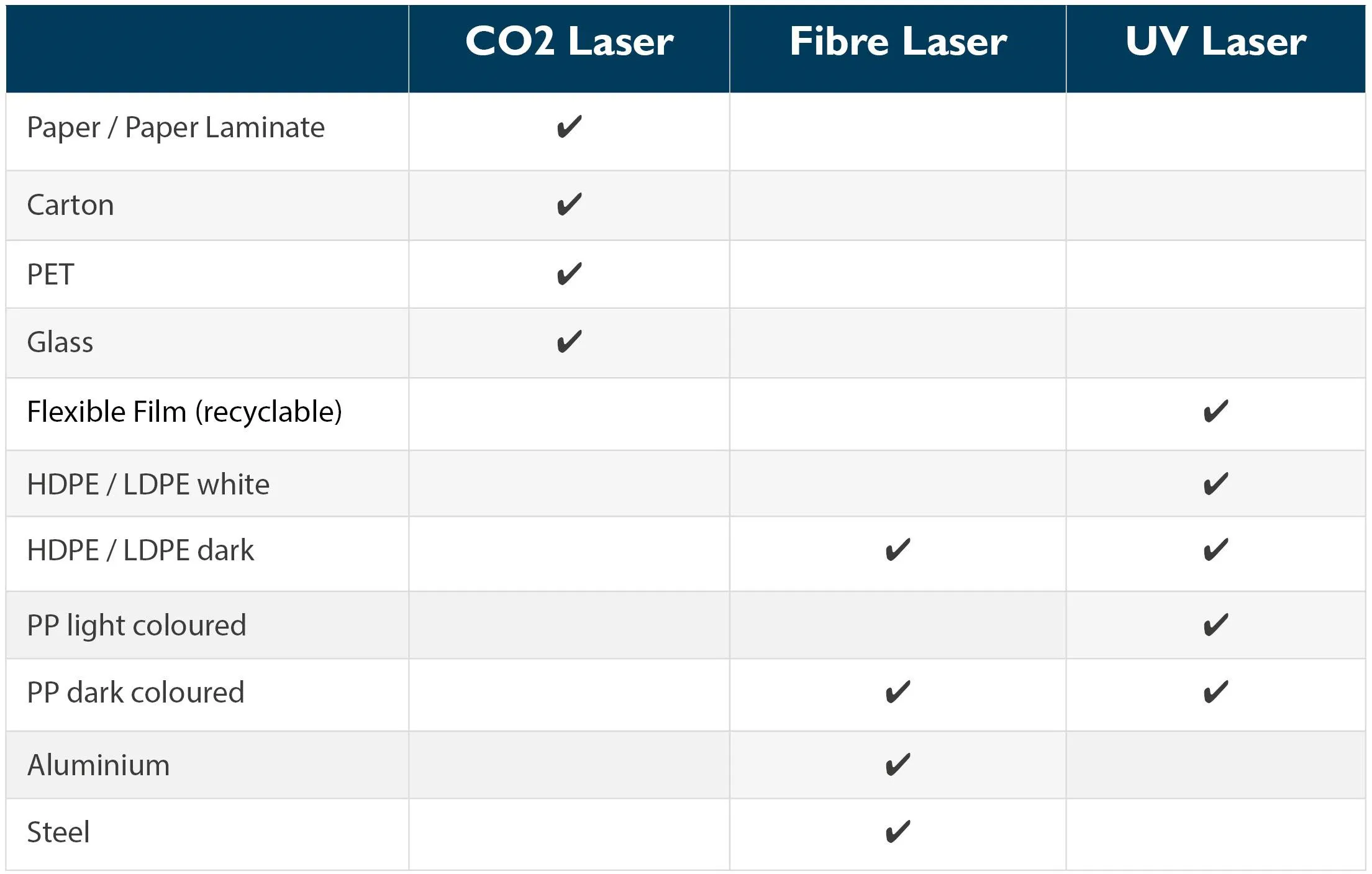In this insight blog, Domino’s laser experts provide an expert overview of laser technologies and how to choose the right solution for your coding and marking needs.
The process of coding and marking involves the application of text, figures, symbols or other shapes on a product or package, in order to satisfy the compliance, traceability, productivity, and branding requirements of global manufacturers. There is a range of technologies typically deployed for applying variable and authentication data, bar codes, promotional codes and unique traceability codes, amongst others, onto products and packaging.
Different types of technologies, including Continuous Inkjet (CIJ), Thermal Inkjet (TIJ), Thermal Transfer Overprint (TTO) offer different benefits for manufacturers’ varying coding and marking needs, so where does Laser marking fit in the mix?
Unlike ink or ribbon-based printing methods, laser technology uses light energy to mark products; using a mirror-guided laser beam, the light energy is directed onto the material, changing the surface of the substrate to create an indelible mark. Laser printing is a non-contact option, ideal for permanent, high-quality coding.
Laser coding offers several advantages
- Its permanent nature means that there is no risk of the code rubbing off or fading with exposure or over time;
- It supports manufacturers’ sustainability goals due to the need for fewer consumables (such as ribbons or inks) and is a chemical-free process;
- Lasers typically require minimal maintenance, increasing production line efficiency and uptime;
- It offers excellent mark quality, with high resolution of numerous lines of text, graphics and machine readable codes in many orientations and fonts;
- It is a highly versatile solution, equally suited for static coding, as well as marking on-the-fly applications at slow and fast-paced production line speeds.

How different laser types work
There are many types of laser technologies available on the market. The three main types are CO2, UV and Fibre lasers. Each laser type is unique and suitable for different materials and tasks. Let’s have a look at the main features and applications for each laser technology. If you want to find out which laser best suits your specific application, please get in touch with us: enquiry@dominoindia.com
1. CO2 laser

A CO2 laser is a type of gas laser. Electric energy is used to fire up the gas molecules, producing light. The ends of the tube are mirrors; one fully reflective and the other letting some light through.
Light produced by CO2 lasers is invisible, falling in the mid infrared range at about 10µm of the light spectrum.
CO2 lasers come in different power classes, and different wavelengths. This makes CO2 lasers highly versatile for absorption by a wide range of substrates and lends itself ideally for glass, paper and clear PET coding.
Domino's CO2 laser coders are available with a high IP65 (dust and water protection) rating, which means they work well in harsh environments such as dairy and beverage production. They also offer excellent printing performance on high-speed product and packaging lines for both human readable and machine readable codes. They are an ideal laser printing solution for dairy, medical, beverage, food, pharma, health and beauty, and tobacco coding and marking.
2. Fibre laser

Fibre lasers use an optical fibre cable doped with special atoms to generate and guide light. The resulting laser beam is more precise than a CO2 laser beam because it has lower divergence and a smaller spot size – making it ideal for small, sharp, perfectly readable codes. Beam characteristics can also be tailored to suit different materials and applications. Fibre lasers also have better energy conversion compared to CO2 lasers, low maintenance and low operating costs. They also produce fewer fumes compared with the CO2 laser (more on that later!).
Due to their wavelength (1.064nm), and high pulse peak power F-Series fibre lasers are very well suited for engraving metal, and generating colour changes in plastic materials. It is an ideal technology for coding beverage and food cans, industrial, medical devices, cosmetics, and electronics.
3. UV laser

Same as fibre lasers UV (ultraviolet) lasers are solid state lasers, but they use special crystals to generate laser radiation at a short wavelength of 355nm. This results in the highest resolution of all three types of laser printer. UV lasers shoot high-energy photons that can break the chemical bonds in the substrate, which causes it to undergo a non-thermal process change – meaning no heat damage or compromised barrier properties on the inner layers of laminated flexible films and nearby areas surrounding the code. This process is called ‘cold coding’.
This makes UV laser printing very versatile.
Domino's U510 UV laser is ideal for all kinds of plastic materials (both light and dark coloured plastic) and recyclables, specifically flexible film (recyclable), white and coloured HDPE, LDPE, and PP.
How Domino can help you find the right laser solution

Different laser technologies lend themselves to different applications, and selecting the right option can depend on a range of factors. The most important factors influencing laser choice are production parameters (static versus on-the-fly coding, speed of production line and product rate), type of substrate to code on, code size, format, quality and durability, and the environment in which the laser is placed.
At Domino, we are experts in helping our customers identify the right solution for their needs – this includes testing the substrate in our purpose-built Sample Lab. Our team of material scientists analyses the characteristics of every substrate to ensure we achieve a proper interaction between the laser and substrate and match the wavelength of the laser beam to the substrate’s absorption. Interested to learn more about this process? Read our blog or watch this video.
Safety considerations
Within any production line environment, health and safety considerations are paramount. This applies to laser printing technologies as with any other technology.
Manufacturers should be aware of fumes that result from the laser coding process and Domino laser printers therefore all come with the option of a fume extraction unit to filter contaminants from the workplace environment. as well as advocating the appropriate use of personal protective equipment.
Correct laser guarding is essential and general laser inspections should be completed on a regular basis. Domino also ensures that, when regulation requires, we offer customer-specific validation packs as part of Good Manufacturing Practice (GMP) product quality assurance.
Conclusion
If you’re currently looking for a laser printing technology and find the array of options overwhelming, we hope this blog has been insightful and informative. However, it is also important to bear in mind that every application is different; working with a specialist coding and marking provider who can provide consultative advice and test your material before investing in the technology, helps deliver a long-term, optimal solution for your business.